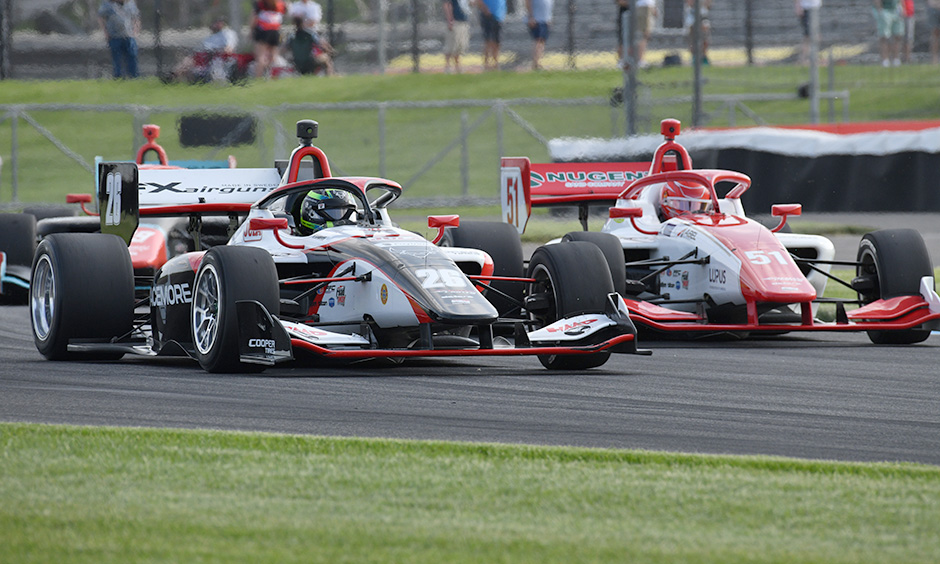Lights Drivers, Teams Welcome New Push-to-Pass Rules
JUN 03, 2022
Indy Lights Presented by Cooper Tires teams must adjust their strategies for the Detroit Grand Prix doubleheader due to a rule change, albeit a welcomed one.
Starting this weekend, the series will adapt the NTT INDYCAR SERIES’ push-to-pass rules – previously announced in February – helping to make the transition from Indy Lights to the INDYCAR SERIES even more seamless for drivers.
“We’ve been asking for it,” said Andretti Autosport Indy Lights team manager Don Lambert. “Since INDYCAR has taken over, they’ve been pushing pretty hard for it.
“We have engineers that feed up to the NTT INDYCAR SERIES. We have the drivers that feed up to INDYCAR. Any of that stuff that we can work on prior to them getting to INDYCAR is a huge plus.”
Previously, drivers had to be within 1.5 seconds of the car in front of them and were limited to a minimum of 15 pushes for 15 seconds. Now, like the NTT INDYCAR SERIES, there is no minimum gap, and there is a maximum use of 15 seconds at any time for a 50-horsepower boost. Drivers will begin with 150 seconds this weekend.
Other highlights include that a push can be pre-armed for up to 10 seconds in advance, with activation starting when throttle exceeds 80%, and will remain on for a minimum of 1 second – or up to 15 seconds – or when throttle falls below 80%.
While it’s unknown how the new push-to-pass rules will affect teams’ strategies for each race until after its Detroit debut, drivers are anxious to put them to the test.
“It’s exciting because it adds another element to it,” said Linus Lundqvist, driver of the No. 26 HMD Motorsports with Dale Coyne Racing car and current Indy Lights points leader. “Before there wasn’t really much you could do with it. As soon as you were in the 1.5 seconds, you used it. It will be interesting to see how this plays out. There is obviously some strategy playing into it. Where to use it? How much to use it? Where do you save?”
Lambert, who has worked in INDYCAR for 33 years and has led Andretti’s Indy Lights program since 2017, said management of the push-to-pass will still be a key element of their strategy, especially since the driver will continue to be the only one who can see how many push-to-passes they have left.
“The timing stand and all engineers are still out of that loop of how much you have,” he said. “Sometimes you’ll tell (the driver), ‘Push to pass,’ and they say, ‘I’ve already used it all.’ ‘OK, well...’ We kind of have to backtrack and try to estimate what other people have used. ‘Well, we think so and so might have two more passes,’ or what have you.”
Hunter McElrea, driver of the No. 27 Andretti Autosport car – one of Lambert’s four drivers – used the Grand Prix of Indianapolis as an example of how the new push-to-pass rule could have changed the game and given the rookie his first win.
Danial Frost passed McElrea for the lead and his eventual first win by using push-to-pass when he was in range. With the new rule, McElrea could’ve had push-to-pass to use, as well, and try to deny Frost’s move by matching his pace. However, McElrea also acknowledged that it depends on how well each driver manages their pushes.
“The big thing now I guess that’s different is you’re so used to it being such an easy pass when you’re right behind someone and they don’t have the button,” he said. “If you have the button, it’s easy to blow by them. Now it’s like, ‘OK… you’re still going to have the draft, which is quite big, but now it’s like, do they have the button, too?’ It mixes up strategy, for sure. Personally, I think it is better.”
Benjamin Pedersen, driver of the No. 24 Global Racing Group with HMD Motorsports car, added the new rule will create a new talking point in strategy meetings, mapping out the smartest way to use it.
“I think it’s just being smart with it,” he said.
The Indy Lights Presented by Cooper Tires field will join the NTT INDYCAR SERIES in Detroit at The Raceway at Belle Isle Park, June 3-5. Live coverage will be provided by Peacock Premium and the INDYCAR Radio Network. For tickets to the weekend, click here.
















